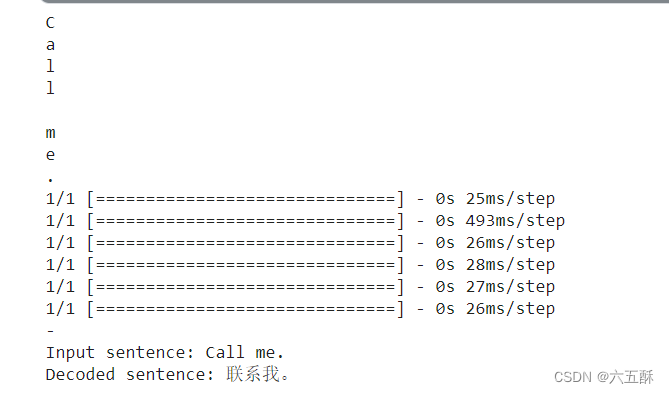系列文章
【如何训练一个中英翻译模型】LSTM机器翻译seq2seq字符编码(一)
【如何训练一个中英翻译模型】LSTM机器翻译模型训练与保存(二)
【如何训练一个中英翻译模型】LSTM机器翻译模型部署(三)
【如何训练一个中英翻译模型】LSTM机器翻译模型部署之onnx(python)(四)
目录
- 系列文章
- 1、加载字符文件
- 2、加载权重文件
- 3、推理模型搭建
- 4、进行推理
模型部署也是很重要的一部分,这里先讲基于python的部署,后面我们还要将模型部署到移动端。
细心的小伙伴会发现前面的文章在模型保存之后进行模型推理时,我们使用的数据是在训练之前我们对数据进行处理的encoder_input_data中读取,而不是我们手动输入的,那么这一章主要来解决自定义输入推理的问题
1、加载字符文件
首先,我们根据 【如何训练一个中译英翻译器】LSTM机器翻译模型训练与保存(二)的操作,到最后
会得到这样的三个文件:input_words.txt,target_words.txt,config.json
需要逐一进行加载
进行加载
# 加载字符
# 从 input_words.txt 文件中读取字符串
with open('input_words.txt', 'r') as f:input_words = f.readlines()input_characters = [line.rstrip('\n') for line in input_words]# 从 target_words.txt 文件中读取字符串
with open('target_words.txt', 'r', newline='') as f:target_words = [line.strip() for line in f.readlines()]target_characters = [char.replace('\\t', '\t').replace('\\n', '\n') for char in target_words]#字符处理,以方便进行编码
input_token_index = dict([(char, i) for i, char in enumerate(input_characters)])
target_token_index = dict([(char, i) for i, char in enumerate(target_characters)])# something readable.
reverse_input_char_index = dict((i, char) for char, i in input_token_index.items())
reverse_target_char_index = dict((i, char) for char, i in target_token_index.items())
num_encoder_tokens = len(input_characters) # 英文字符数量
num_decoder_tokens = len(target_characters) # 中文文字数量
读取配置文件
import json
with open('config.json', 'r') as file:loaded_data = json.load(file)# 从加载的数据中获取max_encoder_seq_length和max_decoder_seq_length的值
max_encoder_seq_length = loaded_data["max_encoder_seq_length"]
max_decoder_seq_length = loaded_data["max_decoder_seq_length"]
2、加载权重文件
# 加载权重
from keras.models import load_model
encoder_model = load_model('encoder_model.h5')
decoder_model = load_model('decoder_model.h5')
3、推理模型搭建
def decode_sequence(input_seq):# Encode the input as state vectors.states_value = encoder_model.predict(input_seq)# Generate empty target sequence of length 1.target_seq = np.zeros((1, 1, num_decoder_tokens))# Populate the first character of target sequence with the start character.target_seq[0, 0, target_token_index['\t']] = 1.# this target_seq you can treat as initial state# Sampling loop for a batch of sequences# (to simplify, here we assume a batch of size 1).stop_condition = Falsedecoded_sentence = ''while not stop_condition:output_tokens, h, c = decoder_model.predict([target_seq] + states_value)# Sample a token# argmax: Returns the indices of the maximum values along an axis# just like find the most possible charsampled_token_index = np.argmax(output_tokens[0, -1, :])# find char using indexsampled_char = reverse_target_char_index[sampled_token_index]# and append sentencedecoded_sentence += sampled_char# Exit condition: either hit max length# or find stop character.if (sampled_char == '\n' or len(decoded_sentence) > max_decoder_seq_length):stop_condition = True# Update the target sequence (of length 1).# append then ?# creating another new target_seq# and this time assume sampled_token_index to 1.0target_seq = np.zeros((1, 1, num_decoder_tokens))target_seq[0, 0, sampled_token_index] = 1.# Update states# update states, frome the front partsstates_value = [h, c]return decoded_sentence
4、进行推理
import numpy as npinput_text = "Call me."
encoder_input_data = np.zeros((1,max_encoder_seq_length, num_encoder_tokens),dtype='float32')
for t, char in enumerate(input_text):print(char)# 3D vector only z-index has char its value equals 1.0encoder_input_data[0,t, input_token_index[char]] = 1.input_seq = encoder_input_data
decoded_sentence = decode_sequence(input_seq)
print('-')
print('Input sentence:', input_text)
print('Decoded sentence:', decoded_sentence)
运行结果:

以上的代码可在kaggle上运行:how-to-train-a-chinese-to-english-translator-iii





:通过代理使用外部工具)


的实现)









概述)
